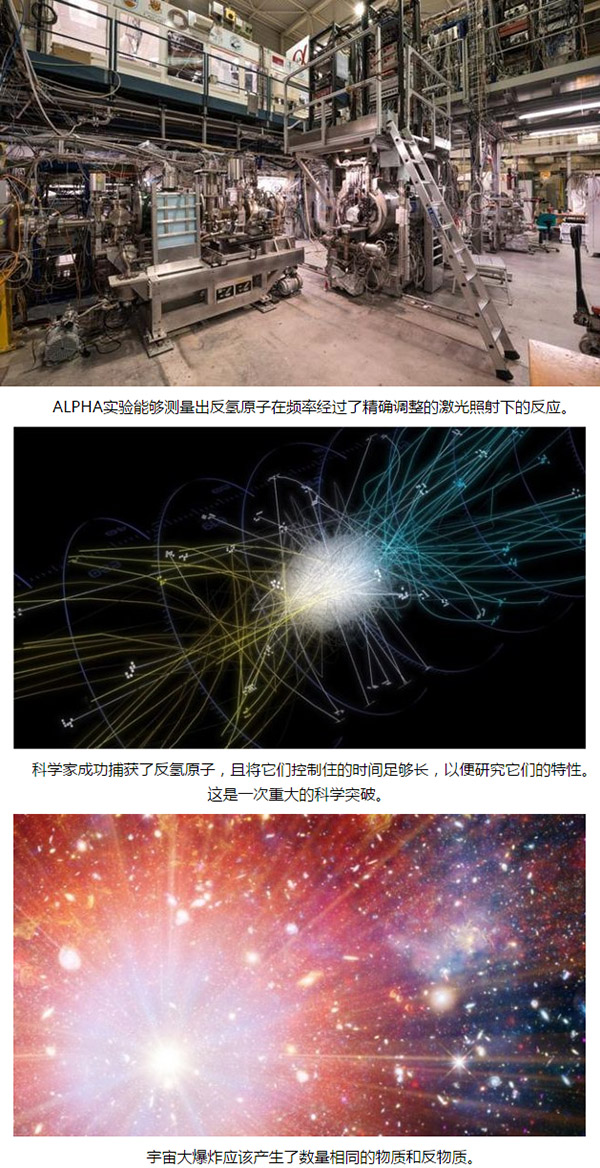According to foreign media reports, scientists at the European Nuclear Center have found a new way to unravel the mystery of antimatter. Physicists let a laser shine on the anti-atoms and see if their reactions are different from the atoms. This study has brought a glimmer of hope for solving the mystery of anti-matter. Although the amount of matter and antimatter produced in the Big Bang was the same, today's universe is mainly composed of matter. At present, there is no theory to explain why this phenomenon occurs.

The preparation and capture of antimatter are extremely difficult because they will instantly annihilate when exposed to common substances. However, using special magnetic traps, the scientists of the ALPHA project of the European Nuclear Power Center successfully studied the characteristics of anti-hydrogen atoms (ie, anti-matter forms of hydrogen atoms).
"What we want to make clear is whether the material and antimatter follow the same physical laws as defined by the standard model," said Prof Jeffrey Hangst, an ALPHA program spokesman.
The standard model theory explains the basic composition of the universe and the various basic forces between them. "Antimatter disappeared after the birth of the universe. This has always been an unsolved mystery. Therefore, we always attach great importance to anti-matter," Professor Hansst added. The ALPHA team described in the experiment report the reaction of the anti-hydrogen atoms they measured under laser irradiation with precisely adjusted frequency.
"We used the same 'color' of light to illuminate the anti-hydrogen and hydrogen atoms and see if their reactions were the same. And so far, the answer is yes," said Professor Hanszt. The team found that the anti-hydrogen atoms behave no different from ordinary hydrogen atoms and fully conform to the standard model theory.
“We want to study carefully the antimatter system that is comparable to the material system we know well. Hydrogen is one of the most basic atoms, and has a history of about 200 years of research. We understand it clearly. Therefore, we will reverse the hydrogen atom. It's really interesting to compare with hydrogen atoms. This is the research goal of our project."
The team hopes to further improve the measurement accuracy in the future. "The accuracy of the measurement is critical, both now and in the future. We can now achieve a precision of 10 minus 10 power, and we hope to achieve a negative 15th power of 10 in the future," said the spokesperson of the ALPHA project.
Even a slight difference in the characteristics of hydrogen atoms and anti-hydrogen atoms will break the basic laws of physics and may help us understand the imbalance between matter and antimatter in the universe. The research team also wanted to study antimatter through other methods. "We are building a new machine, using it to study gravitation, and see what happens if you drop some antimatter. We need to do this experiment."
This machine, named ALPHA-g, is expected to be completed by the end of 2017 and put into use in 2018.
Prior to the results of this latest study, the ALPHA team has experienced many years of effort, such as developing technologies for manipulating ultra-low temperature antiprotons and positrons (electron antimatter forms), capturing anti-hydrogen atoms, and detecting available experimental , a very small number of anti-atoms, and so on.
Four Axis Machining Service,Five Axis Machining,Four Axis Machining,Five Axis Machining Service
Lizhi Precision Manufacturing Technology Co.,Ltd , https://www.lizhihardware.com